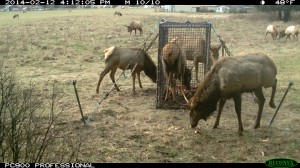Northwest Indian Fisheries Commission
Point Elliott Treaty tribes are expanding efforts to monitor the Nooksack elk herd in hopes of resolving ongoing damage and safety problems in Skagit and Whatcom counties.
The Upper Skagit, Sauk-Suiattle, Swinomish, Stillaguamish, Suquamish, and Tulalip tribes are trapping elk using collapsible traps baited with apples and monitored with wildlife cameras. Since 2012, tribal and state wildlife co-managers have collared at least 10 cow elk with very high frequency (VHF) collars. These collars help estimate the population during annual aerial surveys of the North Cascade elk herd.
To get more precise information about the herd’s movements, the Stillaguamish Tribe’s Natural Resources Department acquired global positioning system (GPS) collars that transmit point location data every 85 minutes. This is a cost-shared project with the Tulalip Tribes. So far, with support from Suquamish, Sauk-Suiattle and Upper Skagit, they have collared five animals and plan to collar four more.
“The main focus of the project is tracking the movement and seasonal habitat use of the lowland elk that frequent the Skagit River Valley and Acme areas,” said Jennifer Sevigny, wildlife biologist for the Stillaguamish Tribe. “These data are important for our future elk management decisions.”
Because of an increasing number of collisions between elk and vehicles, the state Department of Transportation (DOT) is partnering with the tribes to deploy three GPS collars to determine where and when elk are crossing Highway 20. These GPS collars will be programmed differently so they can record location points at closer time intervals to detect more precise crossing locations along Highway 20.
“The GPS collars are more expensive, but they give exact information on where the elk have been,” said Chris Madsen, wildlife biologist for the Northwest Indian Fisheries Commission.
“Up to 50 elk a year may get hit by vehicles along Highway 20,” said Scott Schuyler, natural resources director for the Upper Skagit Tribe. “We’ve suggested creating wildlife underpasses and increasing lighting around the highway to reduce these impacts.”
DOT recently set up flashing elk crossing signs along Highway 20 in response to the increased elk mortality.
The Nooksack elk herd had dwindled to about 300 animals by 2003, prompting state and tribal co-managers to boost the herd by relocating animals from the Mount St. Helens area, and improve forage habitat through restoration projects. The herd has now rebounded to approximately 1,400 elk.
Some property owners and farmers complain that elk from the recovering Nooksack herd destroy fences and devour crops, and have called for removing the lowland population
“All of this work will help give us a better picture of the population dynamics while helping to address the damage issue,” Madsen said. “If we’re going to consider removing elk, we need to put some science behind it.”



